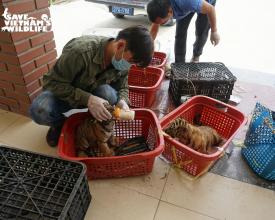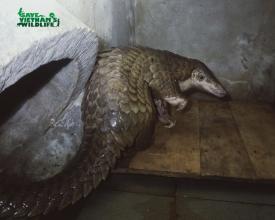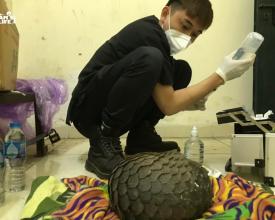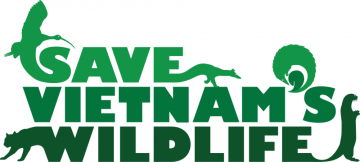
Rescates de fauna salvaje: construir un puente seguro para recuperar las poblaciones salvajes en Vietnam

En Vietnam hay miles de animales salvajes vivos confiscados en incidentes de comercio ilegal de animales salvajes, pero la mayoría de ellos no sobreviven tras la confiscación por falta de un tratamiento adecuado. Los rescates de animales salvajes no se limitan a salvarlos y cuidarlos de las confiscaciones, sino también a rescatarlos y rehabilitarlos, liberarlos y vigilarlos, crear programas de cría para la conservación, desarrollar capacidades y colaborar para devolverlos a su hábitat natural de forma segura y recuperar y asegurar las poblaciones salvajes. Tras 7 años de trabajo, hemos liberado a más de 1.200 animales confiscados, con una tasa de éxito superior al 60%, muchos de los cuales fueron marcados y rastreados tras su liberación. Además, se va a crear una Asociación de Rescate de Fauna Salvaje de Vietnam para apoyar a los centros de rescate de fauna salvaje a través de la red.
Contexto
Défis à relever
En Vietnam se trafica ilegalmente cada año con miles de animales para consumo de carne, medicina tradicional, mascotas y souvenirs. La mayoría de los animales vivos con los que se trafica suelen estar deshidratados, sufrir estrés nutricional, ser portadores de enfermedades o haber sufrido heridas por haber sido atrapados y cazados; muchos de ellos murieron justo después de ser confiscados sin recibir el tratamiento adecuado. Los cazadores furtivos y los traficantes suelen alimentar a la fuerza a los pangolines para aumentar su peso antes de venderlos. Por ello, los animales suelen estar débiles e inmunodeprimidos, por lo que pueden contraer enfermedades zoonóticas y morir fácilmente si no reciben los cuidados adecuados.
Los organismos públicos de Vietnam suelen liberar directamente en su hábitat natural a los animales silvestres confiscados en el comercio ilegal, sin controles sanitarios ni cuarentena, y a menudo fuera de los lugares donde la especie se encuentra de forma natural, lo que a su vez puede suponer una amenaza para las poblaciones silvestres autóctonas.
Ubicación
Procesar
Resumen del proceso
Todas las actividades de rescate, liberación, seguimiento y capacitación deben llevarse a cabo simultáneamente para servir al objetivo final, que es devolver los animales a la naturaleza y recuperar las poblaciones salvajes. Todas las actividades están conectadas y se apoyan mutuamente. El rescate podría proporcionar fundadores y producir conocimientos sobre la cría para apoyar el programa de cría en cautividad. Además, el estudio de las poblaciones cautivas (zootecnia y evaluación sanitaria) ayudaría a mejorar la labor de rescate, por ejemplo, la dieta adecuada de la especie o cuestiones sanitarias generales. El seguimiento de los animales una vez liberados podría darnos información sobre su ecología, dieta y comportamiento, lo que a su vez mejoraría las condiciones de cría para asemejarse a las condiciones naturales, aumentar el bienestar y el éxito reproductor de los animales.
Bloques de construcción
RESCATE Y REHABILITACIÓN DE FAUNA SALVAJE
Junto con el Parque Nacional de Cuc Phuong, hemos creado un centro de rescate y cría llamado "Programa de Conservación de Carnívoros y Pangolines", dentro del PN de Cuc Phuong. El objetivo principal del centro es cooperar con las autoridades para rescatar animales salvajes confiscados en el comercio ilegal y devolverlos a su hábitat natural. Los animales pasan entonces una cuarentena de 30 días. Si cumplen las normas sanitarias, se liberan en zonas protegidas seguras, mientras que los animales que no tienen capacidad para sobrevivir en la naturaleza se mantienen en el centro educativo para animar a los visitantes a contribuir a la conservación de la especie.
Factores facilitadores
- Se pone a disposición de la población una línea telefónica directa para denunciar incidentes de comercio ilegal de especies silvestres.
- Se crea y forma un equipo de respuesta rápida, compuesto por veterinarios y cuidadores de animales, para responder a las llamadas de emergencia de las autoridades o a los informes de la población local.
- Elaborar orientaciones para las primeras respuestas sobre animales
- Aumentar la participación activa y la colaboración efectiva con los guardabosques, y la policía, que han confiscado animales salvajes
- Disponer de un formulario de recogida para registrar la información de la fauna silvestre confiscada, por ejemplo, el lugar del rescate, la especie y el estado del animal para su seguimiento y gestión tras el rescate
Lección aprendida
- Es sumamente importante orientar y asesorar sobre cómo aplicar los primeros auxilios a los animales confiscados a las autoridades y la población local antes de que llegue el equipo de respuesta rápida
- Llegar al lugar del rescate lo antes posible para que los animales tengan más posibilidades de sobrevivir
- Desarrollar una relación con las autoridades de la provincia o distrito responsables de confiscar la fauna silvestre con la que se comercia ilegalmente para que los siguientes eventos de rescate puedan ser más eficaces
LIBERACIÓN Y CONTROL
Nuestro objetivo es que todos los carnívoros y pangolines rescatados, rehabilitados y nacidos en cautividad sean liberados de nuevo en la naturaleza para apoyar la conservación de las poblaciones silvestres; en 7 años se han liberado más de 1.200 animales en el programa. Antes de proceder a la liberación, se evalúa la idoneidad de los lugares de liberación en función de las condiciones del hábitat, los indicios de poblaciones salvajes y las presiones de caza, todo ello con el fin de garantizar las mejores posibilidades de supervivencia de los animales liberados. Hacemos un seguimiento continuo de estas sueltas y de su impacto en las poblaciones silvestres para garantizar que contribuyan a la recuperación de las especies silvestres amenazadas.
Factores facilitadores
- Garantizar que los animales cumplen los requisitos sanitarios antes de su liberación.
- Realizar evaluaciones para garantizar que el hábitat es adecuado para los animales liberados.
- Coordinar con el equipo de investigación el seguimiento de los animales una vez liberados.
- Crear y seguir protocolos de liberación
- Movilizar recursos para apoyar el rescate, la rehabilitación y el seguimiento posterior a la liberación.
Lección aprendida
- No es fácil encontrar hábitats adecuados para rehabilitar algunas especies. A menudo se eligen zonas protegidas para liberar a los animales. Sería útil contar con un sólido equipo de investigación para revisar la bibliografía sobre el historial de distribución de las especies.
- Es importante tener en cuenta la rentabilidad de la liberación de animales, por ejemplo, la distancia entre los centros de rescate y el lugar de liberación.
- Se aconseja liberar animales en zonas semisalvajes antes de que su eventual liberación en la naturaleza pueda garantizar su supervivencia.
- Dado que no es fácil hacer un seguimiento de los animales en los bosques de Vietnam, se prefieren nuevos métodos de rastreo que utilicen técnicas tecnológicas avanzadas, como el uso de drones y cámaras térmicas.
CREACIÓN DE CAPACIDAD PARA LOS CENTROS DE RESCATE
El objetivo de Save Vietnam's Wildlife es garantizar que nuestro centro de rescate sirva de modelo para otros centros de Vietnam en cuanto a gestión del rescate de animales salvajes y normas de bienestar. Somos pioneros en la rehabilitación de pangolines para otras organizaciones vietnamitas y extranjeras, demostrando los más altos niveles de cuidado de los animales y proporcionando a otros centros asesoramiento técnico y formación. Hemos aprovechado el desarrollo de SVW y nuestra mayor capacidad de divulgación para trabajar directamente con otros centros de rescate de Vietnam. SVW ha proporcionado conocimientos técnicos, formación del personal y apoyo logístico y financiero para ayudar a mejorar las normas de bienestar animal y la capacidad de los cuidadores en varios centros de rescate gubernamentales de Vietnam. También hemos contratado a cuidadores de animales y personal veterinario especializados y hemos mejorado las prácticas de cría de animales y los procedimientos de cuarentena.
Factores facilitadores
- Un equipo profesional de cría en cautividad con gran capacidad
- Redactar directrices y protocolos de cría para compartirlos con otras organizaciones, de modo que puedan utilizar nuestras directrices y protocolos para mejorar su calidad; la formación se imparte en función de las necesidades específicas de cada organización.
- Cooperación entre centros de rescate
Lección aprendida
- Es mejor tener instrucciones cara a cara en los centros de rescate que apoyo en línea.
- Es necesario crear una asociación de centros de rescate de fauna salvaje para coordinar las operaciones de rescate en todo el país.
Impactos
Nuestra labor de rescate pretende reducir el número de animales salvajes confiscados muertos y aumentar la tasa de supervivencia y liberación. Nuestra actividad también evita que surjan enfermedades zoonóticas que afecten a las poblaciones silvestres. Utilizamos nuestra cobertura mediática de rescates y liberaciones para ayudar a educar al público y sensibilizarlo sobre las repercusiones del comercio ilegal de especies silvestres. Y lo que es más importante, utilizamos estos rescates para animar y motivar al gobierno a seguir luchando contra el comercio ilegal de especies silvestres.
- Colaboramos con varios centros de rescate gubernamentales para rehabilitar y liberar con éxito a más de 1.000 animales, de los cuales más del 60% fueron liberados con éxito.
- Aumento de la población de pangolines Sunda en el Parque Nacional de Pu Mat mediante la liberación de pangolines confiscados rehabilitados. Esto se ha demostrado mediante pruebas fotográficas de avistamientos de crías de pangolín en el Parque;
- Defender y promover la creación de la Asociación de Centros de Rescate de Fauna Salvaje de Vietnam;
- Muchos otros centros de rescate están recibiendo ayuda, por ejemplo, técnica zootécnica y veterinaria, para mejorar la calidad de su centro.
Beneficiarios
- Poblaciones de animales salvajes, especialmente de fauna silvestre y pequeños carnívoros
- Centros de rescate en Vietnam
- Organismos gubernamentales
- Salud pública y sensibilización
Objetivos de Desarrollo Sostenible
Historia
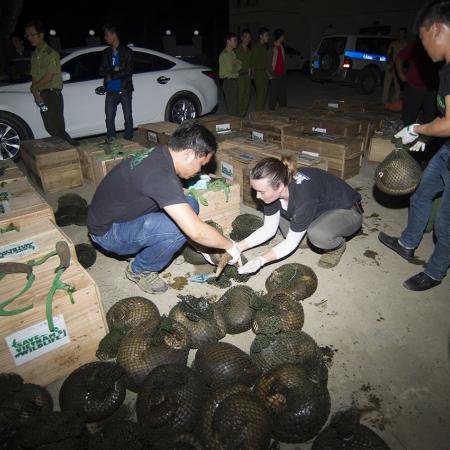
A principios de 2017, hubo un incidente de rescate de 113 individuos de pangolín, el mayor número de animales rescatados jamás en la organización. Los pangolines llegaron todos a la vez cuando solo disponíamos de 30 jaulas de cuarentena y la capacidad de humanos y equipos era muy limitada. Era difícil atender a todos los pangolines del centro. El director de la organización tuvo que movilizar todos los recursos de la organización para rescatar a los animales, incluso varios miembros del personal tuvieron que trabajar hasta medianoche para atender a los pangolines. El trabajo dio sus frutos cuando el 80% de estos animales pudieron ser liberados de nuevo en su hábitat natural.
Además de la liberación de los animales, el mayor logro fue el cambio de actitud de los guardabosques/responsables del gobierno hacia el rescate de la fauna salvaje y el trato correcto a los animales, tras inspirarse en nuestro trabajo y amor por la vida salvaje. Estamos muy contentos de habernos ganado la confianza del gobierno, siempre que hay un caso de rescate de pequeños carnívoros y pangolines, llaman a nuestro equipo de respuesta rápida e incluso preguntan cómo dar a los animales un primer tratamiento para mantener su salud mientras esperan a nuestro equipo. Además, otros centros de rescate también aprenden de nosotros las normas de cría y bienestar animal. El intercambio de conocimientos entre centros de rescate es más frecuente que antes, lo que se cree que aumenta la eficacia del rescate y la conservación de los animales.

